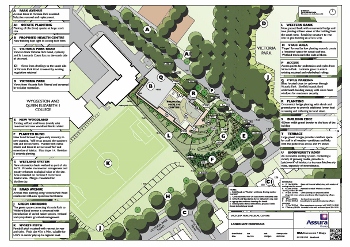Where
Location
VPHC is located next to Victoria park in Leicester off Victoria park Road, in the grounds of Wyggeston college LE2 1DX.
Description
The Victoria Park Health Centre (VPHC) development is a two-storey health centre. The site is roughly 0.7 hectares in size and the site of a WW11 air raid shelter. Work began on the health centre in 2010 and was completed in winter 2013. The landscape design approach was intended to 'tie' the proposed scheme into its context and protect and enhance the landscape setting. The landscape design was developed in tandem with the architectural layout, to ensure that the proposal 'sits' comfortably within the existing landscape.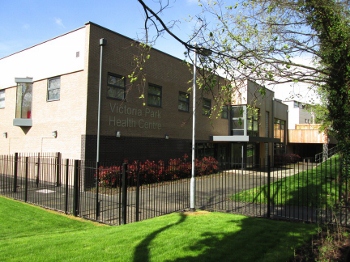
Figure 1: Victoria Park Health Centre main entrance
Figure 2: Landscape proposals (click image to enlarge)
Main SuDS used
The proposal to construct a two storey building in green space in the centre of Leicester demanded sensitive design. It became clear that dealing with the site’s water runoff would require an innovative approach. Early investigations revealed that percolation of water into the ground was a suitable option and so a SuDS scheme was developed, incorporating a ‘biodiversity’ roof and an infiltration basin.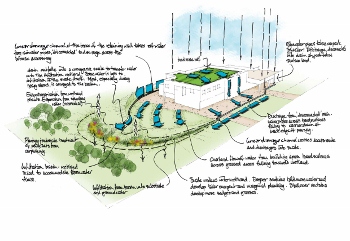
Figure 3: SuDS concept (click image to enlarge)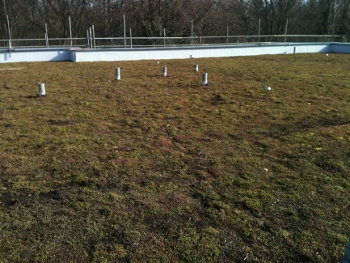
Figure 4: Biodiversity green roof. An all in one modular green roof system with an extensive sedum and lightweight soil-less wildflower mat laid over a 79-80mm substrate.
How it works
Water from the building follows one of two routes. The car park run-off is piped into the marsh and treated there before being allowed to infiltrate into ground. This hasn't had any adverse impacts. The remainder of roof water falls onto the ‘eco’ roof. From there it runs down conventional rainwater pipes, into linear ‘open’ drainage channels and out into the marsh.
Most water is conveyed to the basin, and filtered into substrate and ground water; however, it is also lost through evapotranspiration from wetland plants and from time to time standing water.
There is no ‘discharge rate’ as the system is designed to ‘soak away’. No water flows offsite into the surrounding (road drainage) network. The system return period is designed for a 1 in 100 year event. There is no overflow/exceedance route and no flow control features are used. It’s a relatively small site.
The feature is unlined to allow percolation of surface water into the ground. The wetland is planted with a range of species that treat the water naturally. Together with tree planting and wildflower grassland it introduces a greater range of habitats and ecological benefits than previously existed.
Figure 5: VPMC SuDS - Conceptual Animation
In order to explain the concept a computer model was created to show how the drainage would work.
Specific details
It was envisaged that the wetland would not contain permanent water, since it would not be lined, but would function instead as 'marsh', drying out in warm weather. As such the basin has been planted with mixed marginal species such as reeds, sedges, rushes, yellow flag iris and purple loosestrife. The surrounding landscape has been carefully contoured and is seeded with a mixture of wetland grass and wildflower species such as stalked meadow grass, red clover and birdsfoot trefoil. Native trees were planted to provide a strong landscape framework.
It is anticipated that because the deeper sections of the basins hold more water, they will develop taller emergent and marginal planting, whilst the shallower sections and those that dry out more frequently will favour sedges and grasses.
It was originally intended that swales would link the building to the basin, however space requirements led to the engineers designing a conventional pipe system. This has changed the number of treatment stages available for the car park runoff.
Towards the end of the project the contractor made the gradients around the marshes too steep. It was necessary to meet on site and agree to form more gentle slopes.
The site is subject to a landscape management plan (LMP). The contractors that installed the landscape are covering the 12 months maintenance of the site and DSA have been commissioned to produce an annual inspection and report.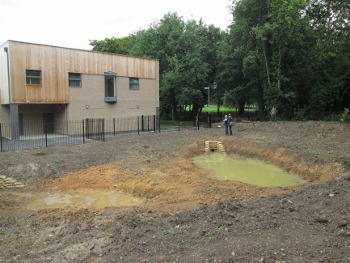
Figure 6: The infiltration basin during construction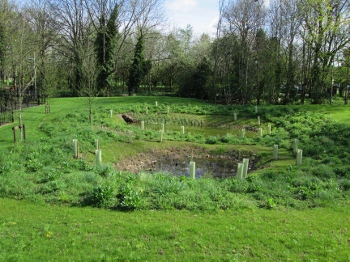
Figure 7: The infiltration basin with wildflower turf and grass seeding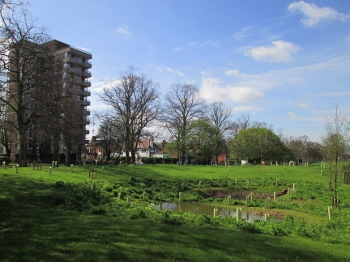
Figure 8: View towards Victoria Park Road and neighbouring residential area
Benefits & achievements
-
The biodiverse roof improves air quality and insulation of the building.
-
Reduces the volume of runoff. Water is treated biologically through the system.
-
Creation of an effective pollutant removal via filtering through the soils.
-
Simple and cost effective solution . Biodiversity potential greatly increased.
-
Infiltration basin manages runoff to ensure clean water enters the natural drainage system.
-
Visual appeal is considerable: basins can be viewed from inside the health care centre.
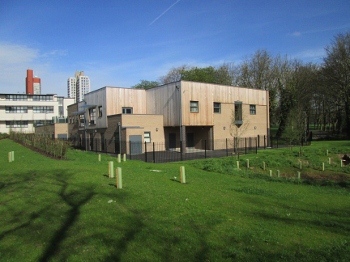
Figure 9: View of the health centre from the bund that partly screens it from the road
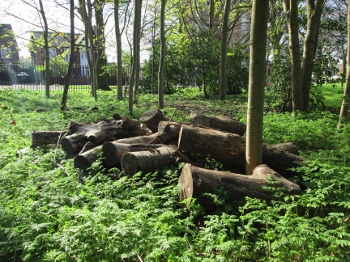
Figure 10: Habitat piles have been created in the existing woodland using timber felled on site
Challenges and lessons learnt
-
DSA, being involved from the outset, were able to propose a ‘soft’ SuDS solution to take advantage of the site levels.
-
The SuDS adopted assisted in gaining planning consent and increasing biodiversity potential. This in turn enabled BREEAM credits to be gained.
-
Unfortunately the original main contractor ceased trading during construction of the building. This caused delays and some design confusion. Three separate engineering consultancies worked on the site.
-
It was originally intended to have swales linking the building to the basin, however space requirements led to a conventional pipe system being used.
-
Being present on site whilst the contractor is forming the landscape can help greatly in achieving a satisfactory result, particularly in terms of achieving the right gradients.
Update May 2016:
The swales continue to work well to this day, with the DSA team regularly monitoring their performance. With much of the planting now established on site, a fantastic environment has been created for wildlife. The site attracts Honey bees and Broad Bodied Chaser.
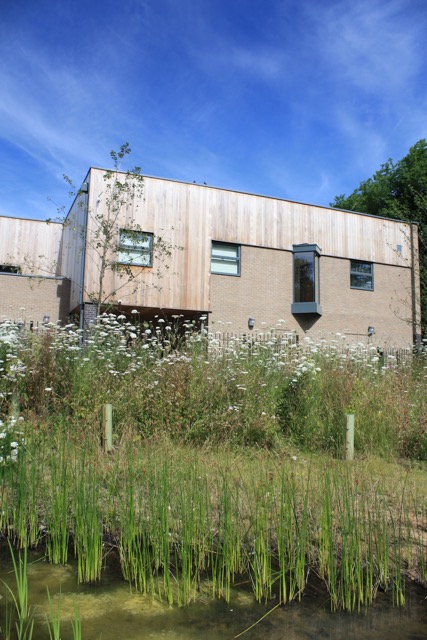
Figure 11: The Swales continuing to work well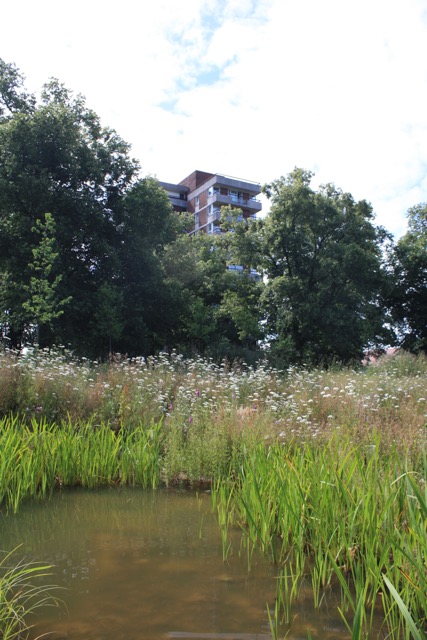
Figure 12: The site provides a natural haven in an urban setting
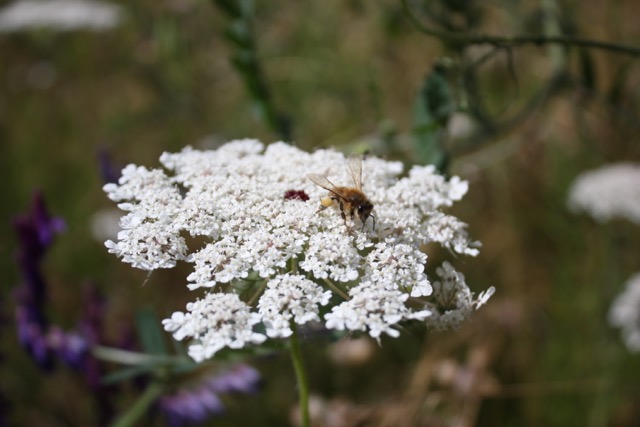
Figure 13: The site attracting a honeybee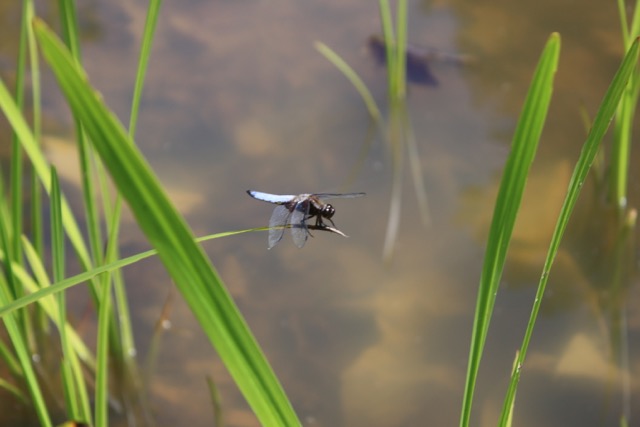
Figure 14: Broad Bodied Chasers are now also found on the site, attracted by Swales.
Team and details
Client: Assura Group
Main Contractor: Primus Build
Landscape Architect: DSA Environment & Design
Engineer: Ward Cole
Architect: West Hart Partnership
Status: Completed Winter 2013
For more details contact: DSA 0115 981 8745 dsa-ed.co.uk
Reviewed: May 2014




